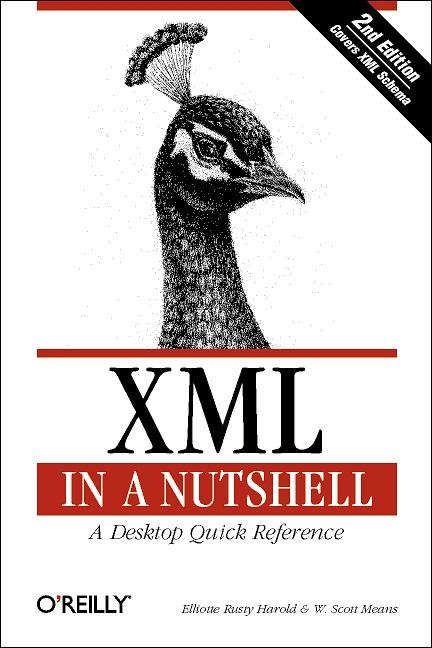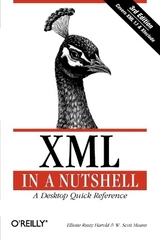
XML in a Nutshell
O'Reilly Media (Verlag)
978-0-596-00292-3 (ISBN)
- Titel erscheint in neuer Auflage
- Artikel merken
W. Scott Means has been a professional software developer since 1988, when he joined Microsoft Corporation at the age of 17. He was one of the original developers of OS/2 1.1 and Windows NT, and did some of the early work on the Microsoft Network for the Advanced Technology and Business Development group. Most recently, he served as the CEO of Enterprise Web Machines, a South Carolina based Internet infrastructure venture. He is currently writing full-time and consulting on XML and Internet topics. Elliotte Rusty Harold is a noted writer and programmer, both on and off the Internet. He started by writing FAQ lists for the Macintosh newsgroups on Usenet, and has since branched out into books, web sites, and newsletters. He's currently fascinated by Java, which is beginning to consume his life. His Cafe Au Lait web site at http://sunsite.unc.edu/javafaq/ is a frequently visited Java site. Elliotte resides in New York City with his wife Beth and cat Possum. When not writing about Java, he enjoys genealogy, mathematics, and quantum mechanics, and has been known to try to incorporate these subjects into his computer books (when he can slip them past his editors). So far he hasn't been able to, but he suspects that a short, last-minute biography might not be inspected as closely as the rest of a manuscript. His previous book is Java Developer's Resource from Prentice Hall.
Preface I. XML Concepts 1. Introducing XML The Benefits of XML Portable Data How XML Works The Evolution of XML 2. XML Fundamentals XML Documents and XML Files Elements, Tags, and Character Data Attributes XML Names Entity References CDATA Sections Comments Processing Instructions The XML Declaration Checking Documents for Well-Formedness 3. Document Type Definitions (DTDs) Validation Element Declarations Attribute Declarations General Entity Declarations External Parsed General Entities External Unparsed Entities and Notations Parameter Entities Conditional Inclusion Two DTD Examples Locating Standard DTDs 4. Namespaces The Need for Namespaces Namespace Syntax How Parsers Handle Namespaces Namespaces and DTDs 5. Internationalization Character-Set Metadata The Encoding Declaration Text Declarations XML-Defined Character Sets Unicode ISO Character Sets Platform-Dependent Character Sets Converting Between Character Sets The Default Character Set for XML Documents Character References xml:lang II. Narrative-Centric Documents 6. XML as a Document Format SGML's Legacy Narrative Document Structures TEI DocBook Document Permanence Transformation and Presentation 7. XML on the Web XHTML Direct Display of XML in Browsers Authoring Compound Documents with Modular XHTML Prospects for Improved Web-Search Methods 8. XSL Transformations (XSLT) An Example Input Document xsl:stylesheet and xsl:transform Stylesheet Processors Templates and Template Rules Calculating the Value of an Element with xsl:value-of Applying Templates with xsl:apply-templates The Built-in Template Rules Modes Attribute Value Templates XSLT and Namespaces Other XSLT Elements 9. XPath The Tree Structure of an XML Document Location Paths Compound Location Paths Predicates Unabbreviated Location Paths General XPath Expressions XPath Functions 10. XLinks Simple Links Link Behavior Link Semantics Extended Links Linkbases DTDs for XLinks 11. XPointers XPointers on URLs XPointers in Links Bare Names Child Sequences Namespaces Points Ranges 12. Cascading Style Sheets (CSS) The Three Levels of CSS CSS Syntax Associating Stylesheets with XML Documents Selectors The Display Property Pixels, Points, Picas, and Other Units of Length Font Properties Text Properties Colors 13. XSL Formatting Objects (XSL-FO) XSL Formatting Objects The Structure of an XSL-FO Document Laying Out the Master Pages XSL-FO Properties Choosing Between CSS and XSL-FO 14. Resource Directory Description Language (RDDL) What's at the End of a Namespace URL? RDDL Syntax Natures Purposes III. Data-Centric XML 15. XML as a Data Format Why Use XML for Data? Developing Data-Oriented XML Formats Sharing Your XML format 16. XML Schemas Overview Schema Basics Working with Namespaces Complex Types Empty Elements Simple Content Mixed Content Allowing Any Content Controlling Type Derivation 17. Programming Models Common XML Processing Models Common XML Processing Issues 18. Document Object Model (DOM) DOM Foundations Structure of the DOM Core Node and Other Generic Interfaces Specific Node-Type Interfaces The DOMImplementation Interface Parsing a Document with DOM A Simple DOM Application 19. Simple API for XML (SAX) The ContentHandler Interface SAX Features and Properties Filters IV. Reference 20. XML 1.0 Reference How to Use This Reference Annotated Sample Documents XML Syntax Constraints XML Document Grammar 21. Schemas Reference The Schema Namespaces Schema Elements Instance Document Attributes 22. XPath Reference The XPath Data Model Data Types Location Paths Predicates XPath Functions 23. XSLT Reference The XSLT Namespace XSLT Elements XSLT Functions TrAX 24. DOM Reference Object Hierarchy Object Reference 25. SAX Reference The org.xml.sax Package The org.xml.sax.helpers Package SAX Features and Properties The org.xml.sax.ext Package 26. Character Sets Character Tables HTML4 Entity Sets Other Unicode Blocks Index
| Erscheint lt. Verlag | 23.7.2002 |
|---|---|
| Zusatzinfo | index |
| Verlagsort | Sebastopol |
| Sprache | englisch |
| Maße | 153 x 228 mm |
| Gewicht | 762 g |
| Einbandart | kartoniert |
| Themenwelt | Informatik ► Programmiersprachen / -werkzeuge ► XML |
| Mathematik / Informatik ► Informatik ► Web / Internet | |
| ISBN-10 | 0-596-00292-0 / 0596002920 |
| ISBN-13 | 978-0-596-00292-3 / 9780596002923 |
| Zustand | Neuware |
| Haben Sie eine Frage zum Produkt? |
aus dem Bereich

